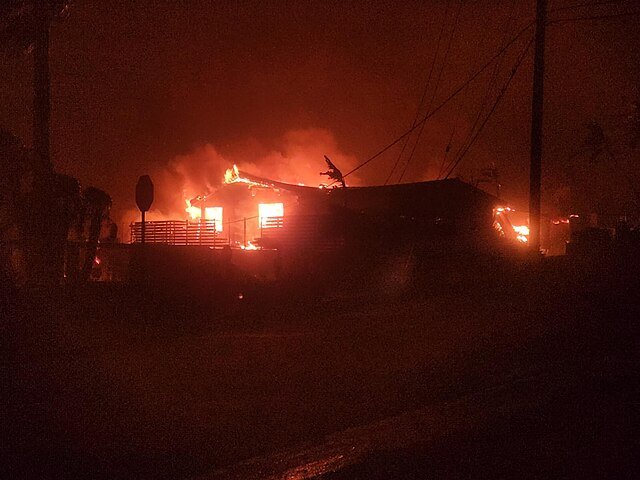Los Angeles was hit by a literal firestorm a bit over a week ago, and I've largely kept out of the social media and blogosphere hullabaloo, but I think it is finally time to add my voice. People are playing the blame game of climate change fearmongering and partisan politics, but I want to offer some lessons we need to learn about practical actions we can take instead.

Watch the forecasts
I don't trust the government, and meteorologists can be wrong, but I still suggest keeping an eye on your local agency announcements. In the US, the National Interagency Fire Center, InciWeb, and the National Weather Service provide forecasts and warnings about local conditions including overall weather reports and specific imminent concerns
Here in the Pacific Northwest where I live, we need to watch the fire season forecasts during the summer and the snowstorm forecasts in winter. This is not paranoia, just awarness of precautions we may need to take as we go about life.
For Los Angeles, there were warnings several days in advance of high winds combined with persistent drought conditions. A fire weather watch was in place on January 2nd. A Red Flag Warning was announced shortly before all hell broke loose. These indications are not to be taken lightly.
Plan ahead
Let this be another reminder to build a go bag. I've written before about preparing an emergency kit and planning what to pack in case of evacuation, with layers of priority based on time and space considerations. I recommend ready.gov as a good starting point with checklists and basic tips that go a long way toward preparing for any emergency, including wildfire.
I hosted programs at the library over the years discussing fire-wise landscaping and creating a defensible space around your home. Making choices about your yard can make a huge difference in the rate fires spread in rural and suburban areas. If your yard is less flammable, your house is safer.
As a draftsman, I specified construction with fire resistance as a consideration. This is a bigger project, but if you are building new or remodeling your exterior, you can do a lot to give yourself more time, if not prevent many hazards outright. Fiber cement siding is much more fire-resistant than traditional wood or cheap vinyl siding while looking more like the former. As a bonus, it's also moisture-resistant for the opposite weather extreme. Metal and masonry exteriors also offer fire resistance. Metal roofing can prevent hot embers from igniting your house. Wood framing has a lot of advantages, but insulated concrete forms or more traditional masonry may better serve your purposes. Consider your options and weigh cost, durability, and protection from the elements you may face.
Don't rely on the State
Plan your evacuation routes with alternatives to avoid main roads in case they are crowded. If you can see a disaster looming, try to evacuate ahead of the crowd. Waiting for government to issue a notice may be waiting too long. Staying through the disaster may mean waiting for help that will never come.
The Los Angeles Fire Department apparently had a combination of overwhelming demand on their resources plus failures in water delivery and other logistics. Earlier in 2024, FEMA left people feeling abandoned after hurricanes Helene and Milton hit the eastern US. Worse still, anecdotal evidence suggests the higher the level of government "emergency management," the more interference there is with volunteer efforts and local emergency responders. We have even seen literal war brought to the doorsteps of Ukrainians, Israelis, and Palestinians.
In short, government is likely to utterly neglect you, or else get in the way and make things worse when resources are scarce and time is of the essence. Assume no one will come to your rescue, so be ready to rescue yourself and your neighbors.
Know it can happen to you
The prepper and survivalist community ranges from folks like me with some core emergency items squared away to folks who build bomb shelters and plan for total civilization collapse. Most of the time, we're subjected to mockery. A related double standard is often leveled at American gun owners: "Why do you need a gun? Just call the police," but also, "OMG! America is basically a war zone with danger at every turn, and the cops are either corrupt or incompetent!" Prior to COVID, hurricanes, and wildfires, the usual line was, "why would you store food and plan to hunker down or bug out?" Do you have your answer yet?
Every disaster should be a reminder that emergencies do happen, and they can happen to you. In the end, you are always your own first responder. Take a few precautions to protect yourself and be ready to help others. There's nothing crazy about rational risk assessment or taking practical steps based on that assessment.
Does that just mean keeping a first aid kit in your car? Do that—TODAY—and schedule a first aid & CPR class.
Does that mean getting body armor, taking rifle training, and building a bomb shelter? Maybe you can't do that all at once, but take some practical steps toward making that happen.
I'm not advising living in fear, although that accusation is often made by people content to coast through life and hope for the best. I'm saying part of our duty to ourselves and others is to at least not be another helpless victim of circumstance if possible.
Can you plan for everything? Of course not, but you can cover a lot of basics with little expense or effort.
Will it always work? Probably not, but we see the people who failed this duty all over the news this week while politicians and officials play the blame game.
That needs to be the primary lesson we all learn from L.A.
Class dismissed.
